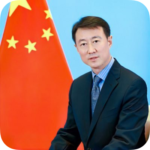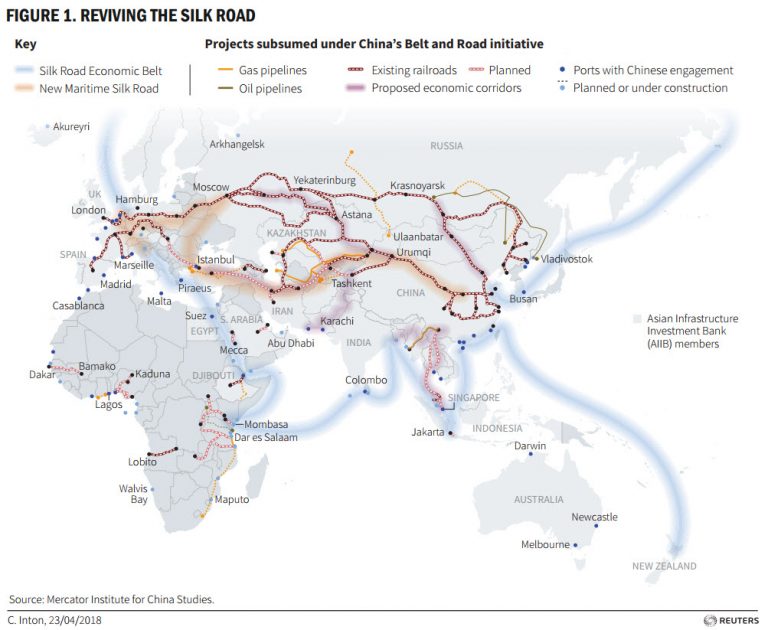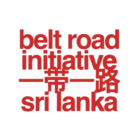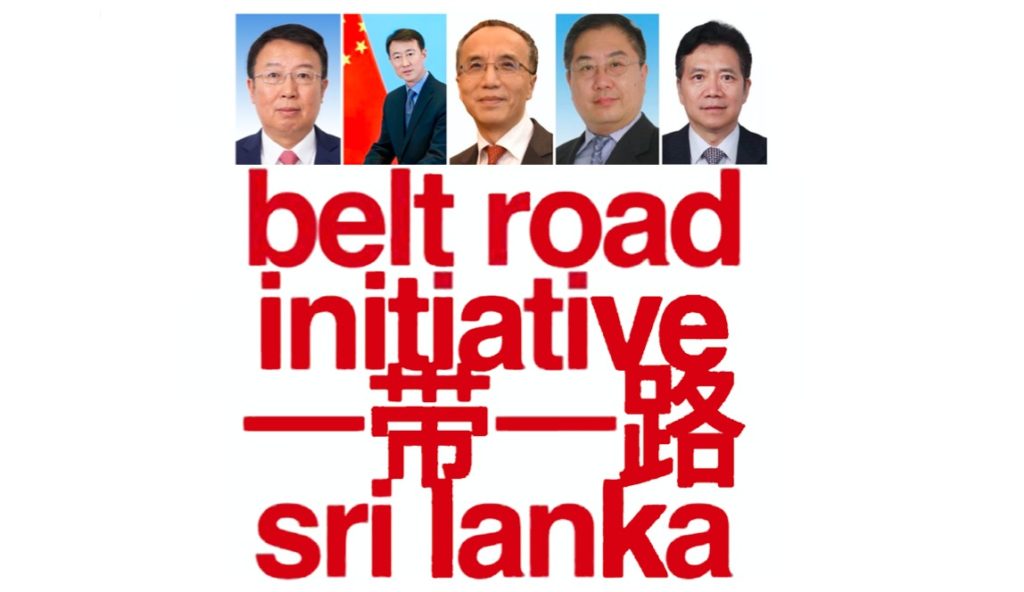Belt & Road Initiative Building a Shared Vision
The Belt & Road Initiative (BRI) is considered China’s most ambitious plan in the modem era. The first public announcement was made by President Xi Jinping in September 2013 in his official visit to Kazakhstan and he raised the initiative of jointly building the Silk Road Economic Belt and the 21st-Century Maritime Silk Road. The “Belt” includes countries situated on the original Silk Road through Central Asia, West Asia, the Middle East, and Europe will consist of six economic corridors connecting China to the far reaches of Eurasia by road and rail. The “Road” is a complementary initiative aimed at investing and fostering collaboration in Southeast Asia, Oceania, and North Africa, through several contiguous bodies of water – the South China Sea, the South Pacific Ocean, and the wider Indian Ocean area. Currently, there are more than 150 countries and international organizations signed agreements on BRI cooperation with China.
The BRI is generally popular in the developing world, where most of the countries face infrastructure deficiencies. Some of the notable projects include the Addis Ababa-Djibouti Railway – Ethiopia, Entebbe-Kampala Expressway – Uganda, Nairobi-Mombasa rail line – Kenya, Abuja-Masaka light rail – Nigeria, Jakarta-Bandung High Speed Rail – Indonesia, Colombo Port City and Hambantota port – Sri Lanka, Piraeus Port – Greece, Temburong Bridge – Brunei, Padma Bridge – Bangladesh, Punta Sierra Wind Farm – Chile, Yamal LNG Project – Russia, China-Belarus Great Stone Industrial Park – Belarus, Djibouti International Free Trade Zone – Djibouti, Budapest-Belgrade High-Speed Railway – Hungary/ Serbia, China-Maldives Friendship Bridge – Maldives, China-Myanmar Oil Pipeline – Myanmar, Dhaka Elevated Expressway – Bangladesh, East Coast Rail Link Project – Malaysia, Gwadar Port – Pakistan.
In the recent keynote speech delivered at the opening ceremony of the Boao Forum for Asia Annual Conference 2021, Chinese President Xi Jinping outlined a new vision for the joint building of the Belt and Road Initiative, saying that China will endeavor to build a closer partnership for health cooperation, connectivity, green development, openness and inclusiveness. Further Xi reiterated China’s commitment to make the BRI “a public road open to all” instead of a “private path owned by one single party”. “All interested countries are welcome aboard to take part in the cooperation and share in its benefits. Belt and Road cooperation pursues development, aims at mutual benefits and conveys a message of hope,” he said.
Speaking at a Communist Party study meeting held on 1st June 2021, Xi said it was crucial for China to improve its ability to spread its messages globally in order to present a “true, three-dimensional and comprehensive China”. Further Xi said China needed to develop an “international voice” to match its national strength and global status. It also needed to strengthen publicity efforts to help foreigners understand the Communist Party of China and the way it “strives for the happiness of the Chinese people”. The country needed to create a team of professionals and adopt “precise communication methods” for different regions, Xi said. Belt & Road Initiative Sri Lanka (BRISL), a Sri Lankan organization pioneer in promoting BRI and cheering for Mutual Benefit and Win-win Cooperation though BRI, recently contacted some of the Chinese diplomats around the world to get their opinion about BRI to show the world about China’s unified strategic vision of BRI.

Ambassador Deng Xijun
Mission of People's Republic of China to ASEAN
The Belt and Road Initiative (BRI) is a public product proposed by China and widely welcomed by the international community. It is a process of open, inclusive and common development with the principles of extensive consultation, joint contribution, and shared benefits. Since its launch in 2013, the BRI has advanced in solid steps in terms of policy coordination, connectivity of infrastructure, unimpeded trade, financial integration and closer people-to-people ties. By January 2021, China has signed 205 documents on the BRI cooperation with 140 countries and 31 international organizations. Cooperative partners have obtained tangible benefits, and their appreciation of and participation in the BRI is increasingly growing. China will continue to step up efforts to promote high-quality development of the BRI, which has been clearly illustrated by its new 14th Five-Year Plan (2021-2025) for National Economic and Social Development.
ASEAN is one of China’s most important neighboring regions and a key partner in the high-quality development of the BRI. All ASEAN member states have signed BRI cooperation agreements with China. In November 2019, China and ASEAN signed a joint statement on synergising the BRI and the Master Plan on ASEAN Connectivity 2025. China and ASEAN have achieved fruitful results in the BRI cooperation, contributing towards regional connectivity, economic prosperity and sustainable development and the building of the China-ASEAN community with a shared future. I am glad to see that many landmark projects such as the China-Laos Railway and the Jakarta-Bandung High-Speed Railway are progressing smoothly. As particular, China and ASEAN have developed as each other’s largest trading partners. This year marks the 30th anniversary of dialogue relations between China and ASEAN. I believe the joint efforts on the BRI cooperation will further boost regional economic recovery from COVID19, create more growth opportunities for trade and investment, and jointly usher in an even more exciting next 30 years for China and ASEAN.

Ambassador Wu Peng
Director-General,
Department of African Affairs,
MFA, China
The Belt and Road Initiative is basically about infrastructure which is what’s in desperate need in many countries on the African continent. And that’s why Africa has become an important participant of the Belt and Road Initiative since it was put forward in 2013. 46 African countries and AU commission have so far signed the BRI cooperation documents with China. Africa has thus become one of the most active and committed partners in the Belt and Road cooperation, adding strong impetus to the growth of China-Africa relations. We have come a long way in our cooperation with Africa in the framework of BRI, to name but a few success stories: The National Road No. 1 of Republic of Congo inaugurated in 2016. Mombasa-Nairobi Standard Gauge Railway entered into operation in 2017. Thiès-Touba Highway of Senegal and Maputo-Katembe bridge of Mozambique, the longest crossing-bridge in Africa, completed in 2018. As is obvious to all, a host of infrastructure projects have brought tangible benefits to the African people.
Belt and Road Initiative is also an important subject of FOCAC. At the 2018 FOCAC Beijing Summit, China and Africa agreed to jointly build an even stronger community with a shared future, developing synergy between the Belt and Road cooperation, the 2063 Agenda of the African Union, and the development strategies of individual African countries, which will realize win-win cooperation, mutual development and play an exemplary and leading role in building a community with a shared future for mankind.

His Excellency Liu Hongyang Ambassador of China to the Republic of Malawi
World history is a grand book of human development through integration, of which the aim is to seek happiness and make a better life for the people. Belt and Road Initiative just serves the purpose. Back in October 2013, I was the deputy Ambassador of China to the Republic of Indonesia. I was lucky to welcome His Excellency Xi Jinping, President of the People’s Republic of China, paying an official visit to Indonesia after his attendance in the APEC Economic Leaders Meeting in Bali. On October 3rd, President Xi was invited to deliver a speech at the Parliament of Indonesia. In that famous speech “Jointly Building a Community of China and ASEAN”, President Xi announced the initiative of building a maritime silk road together with southeast Asian countries. The initiative received wide support.
We have seen that many countries around the world have participated in Belt and Road Initiative since it was announced in 2013 and tangible results have been witnessed. One would wonder why so many countries have joined the Belt and Road Initiative. The reason is very simply. The initiative is an economic initiative in nature and participating countries can benefit from it. At present, there are 46 African countries that have joined Belt and Road. Win-win cooperation is flourishing in Africa. I am confident that with joint efforts among participating countries, Belt and Road will become two strong wings of global economy in the 21st century.

His Excellency Yu Dunhai Chinese Ambassador to the Republic of Malta
BRI is an economic cooperative platform and a public goods initiated by China but benefits the whole world. It is open, inclusive and sustainable. It has already contributed to the alleviation of millions of people out of poverty, creation of new job opportunities and promotion of livelihood around the world.

His Excellency LI Xiaosi Chinese Ambassador to Republic of Austria
The Belt and Road Initiative is an international platform for economic cooperation. All countries, big or small, rich or poor, strong or weak, despite their different ideologies and political systems, can participate voluntarily. It is true multilateralism. Although there have been many slanders and smears, the positive impacts of the Belt and Road Initiative for the economic development and improvement of people’s lives in countries involved, especially developing countries, are more than clear. Unity is strength. We all should stand on the right side of history and do the right thing. As a long road tests the strength of a horse, so time reveals one’s heart.




